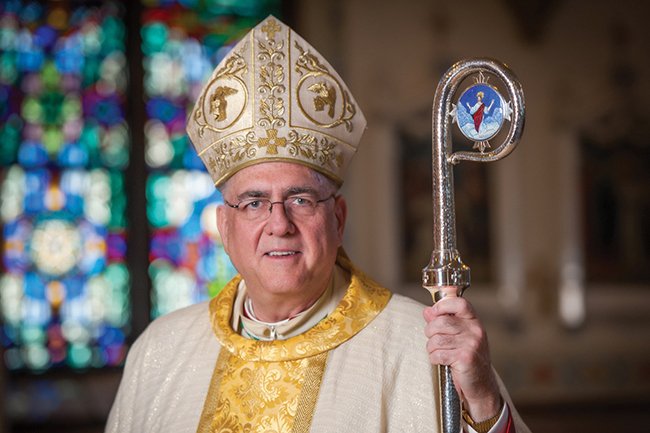by Archbishop Joseph F. Naumann
Prior to my priestly ordination in 1975, I never had a one-on-one meeting with the archbishop of St. Louis, John Cardinal Carberry. For that matter, I never had a one-on-one meeting with the cardinal after I was ordained.
It was a different era. The number of men in the seminary was still strong. I was one of 14 new priests ordained for the Archdiocese of St. Louis in 1975. The prior year, 22 men were ordained as priests for St. Louis.
I understood the theology that priests only serve in communion with the local bishop. I had tremendous respect for bishops but, as a seminarian and a young priest, my goal was to avoid bishops as much as possible.
I enjoyed each of my parochial assignments as a young priest. From my perspective, nothing good could come from catching the attention of the bishop, since he could transfer me from my present assignment.
From my viewpoint, there were three probable reasons for a bishop to call me: 1) I was in trouble! 2) I was being transferred; 3) I was being asked to take on some additional responsibility. I was hoping for none of the above. I thought it best to do what I could to keep off the bishop’s radar screen. You can see how well that strategy worked for me! God definitely has a great sense of humor.
When I arrived in the Archdiocese of Kansas City, I was impressed by the time and personal attention that Archbishop Keleher gave to promoting priestly vocations and to spending time with seminarians and potential seminarians. I was grateful to Archbishop Keleher for the number and quality of seminarians for our archdiocese.
It was clear to me that one of the most important responsibilities of a bishop is the ordination of priests. A dedicated and zealous priest can influence tens of thousands of individuals over the course of his priestly life. Nothing else that I do has the same potential for a long and lasting impact.
I attempt to visit all of our seminaries at least once a year and to schedule one-on-one meetings with all of our men in pre-theology and theology. My recent trip to Rome was primarily to spend time with our two seminarians (Carter Zielinski and Joe Heschmeyer) studying at the Pontifical North American College as well as to meet with their formators.
I have not been in Rome since Carter and Joe began their studies. Unfortunately, I am not able to go this coming fall, when Carter and Joe will be ordained transitional deacons. God willing, I will ordain them priests in the spring of 2018.
The faculty and students of the North American College have for decades sponsored English-speaking Masses at the stational churches in Rome during Lent. The custom of visiting the stational churches dates back to Pope St. Gregory the Great (590-604). A different stational church is designated for each day of Lent.
I was given the privilege to celebrate Mass for Tuesday of the Second Week of Lent at the Basilica of St. Balbina. According to legend, St. Balbina was the daughter of Quirinius, a tribune in the Roman army. Having been cured from a debilitating disease by kissing the chains that once shackled St. Peter, Balbina and her father converted to Christianity. A statue of St. Balbina is one of those that adorn the roof of the colonnade surrounding St. Peter’s Square.
The 7 a.m. Mass at St. Balbina was packed with seminarians from the North American College, as well as many other American college students who are studying in Rome. It was beautiful to see the faith and love for Our Lord in the Eucharist evidenced not only by the seminarians, but by so many other young American students.
Since the seminarians and other students had to catch breakfast and get to classes, my homily was brief — another miracle attributed to St. Balbina. Actually, it was a bit intimidating to give the homily after attending the Carl J. Peter Lecture on Homiletics given by Bishop Charles Jason Gordon of Bridgetown, Barbados. Bishop Gordon gave a powerful and challenging talk on the importance of the Sunday homily.
I was also able to attend a reflection on celibacy given by Father Joseph Carola, SJ, who had given the January retreat to the bishops of Kansas, Missouri, Iowa and Nebraska. Father Carola gave a very thoughtful explanation of the meaning and importance of celibacy. He reminded the seminarians that the purpose of celibacy is not a utilitarian one so that they are freer to serve wherever the church most needs them, but the witness it gives to God’s people of giving God primacy in our lives.
It was good for me to catch a glimpse of the formation that Carter and Joe are receiving at the North American College. I hope and pray that my time in Rome was a source of encouragement to Carter and Joe as they are just a little more than a year away from priestly ordination. I hope it helped them develop a better attitude toward bishops than I did as a seminarian and a young priest.
My time spent with the seminarians at the North American College certainly renewed my hope for the future of our church, not just in northeast Kansas, but throughout the entire United States. Please keep Carter, Joe and all our Kansas City, Kansas, seminarians in your prayers. I am grateful to God for blessing us with so many and such high quality seminarians. Please pray for me that I may do my part in attempting to form priests who will serve the people of our Archdiocese for many decades to come.


